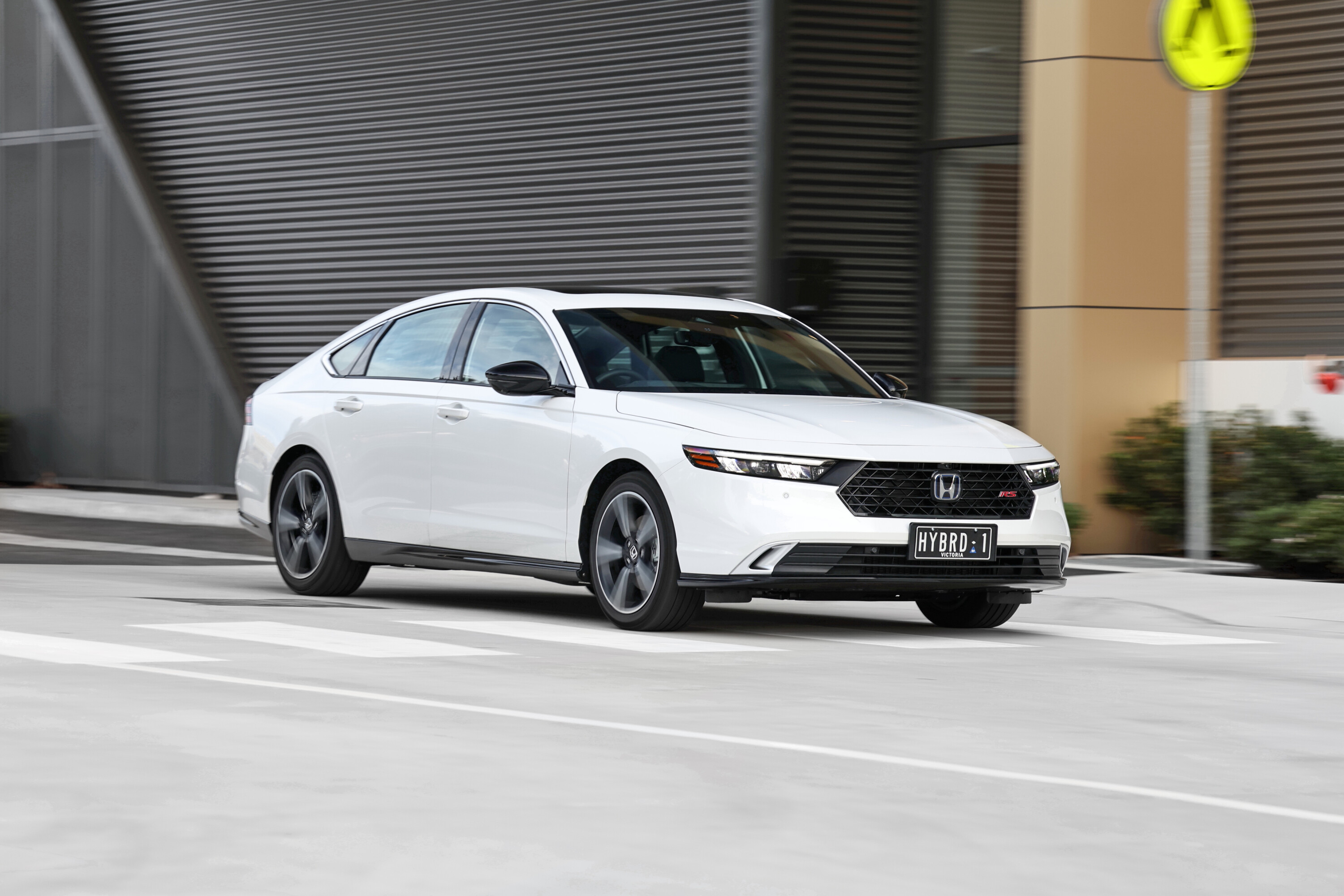Score breakdown
Things we like
- Efficient, smooth hybrid powertrain
- Up-to-date technology
- Spacious, practical cabin
Not so much
- Dearer than its rivals; limited to one variant
- Tight rear headroom
- Lacks spare wheel; no heated or cooled seats
The 11th-generation 2024 Honda Accord sedan has arrived in Australia 18 months after it debuted, continuing a legacy that started in 1977 despite dwindling sales in recent years.
An oft-forgotten rival to the Toyota Camry, Mazda 6, Skoda Superb and Hyundai Sonata, the latest Accord is now available in a sole hybrid E:HEV RS variant with the 1.5-litre turbo-petrol option deleted.
It costs $64,900 drive-away – a $3000 increase over the previous Accord VTi-LX Hybrid and far dearer than the medium sedan of choice (the Camry).

The Accord’s target audience continues to be older buyers and rideshare drivers standing out from the Camry status quo, with otherwise limited sales potential due to continued demand for SUVs and utes in Australia.
How limited? Honda Australia sold just 144 units of the Accord in 2023 – less than the Lamborghini or Bentley line-ups and equivalent to a day’s worth of Ford Ranger or Toyota HiLux sales – and it admits there won’t be much improvement for the new model.
This is despite Toyota selling more than 10,000 units of the Camry – showing demand is still there when a brand ticks the right boxes – while 1528 Mazda 6s, 338 Hyundai Sonatas and 278 Skoda Superbs were also delivered in 2023.
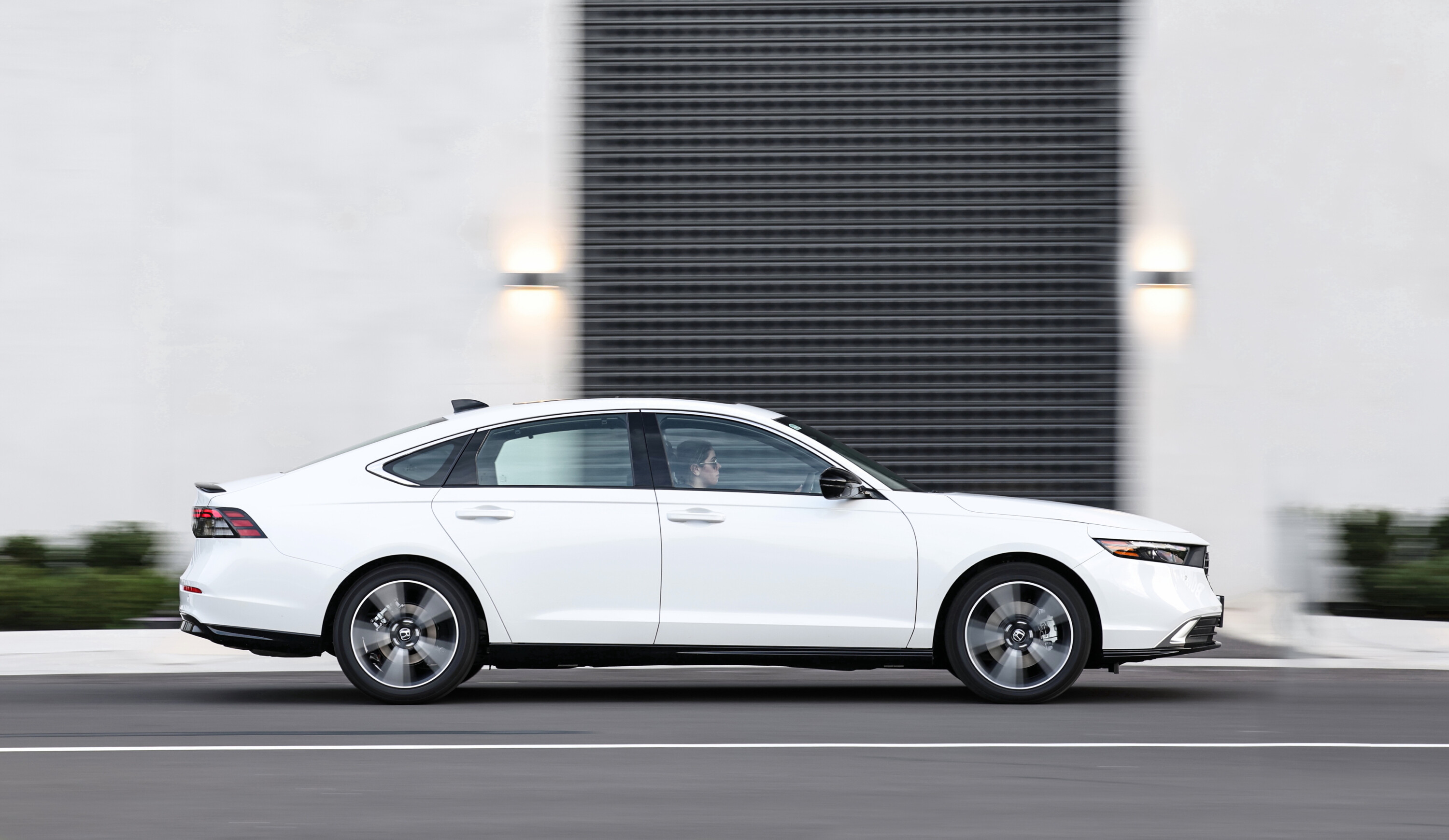
JUMP AHEAD
- How much is it, and what do you get?
- Where is this model in its lifecycle?
- How do rivals compare on value?
- Interior quality, comfort, space and storage
- Technology in the cabin
- What is it like to drive?
- How is it on fuel?
- How safe is it?
- Warranty and running costs
- VERDICT
- Specifications
How much is it, and what do you get?
| 2024 Honda Accord E:HEV RS features | |
|---|---|
| 18-inch alloy wheels | LED exterior lighting |
| 12.3-inch infotainment systemu00a0 | 10.2-inch digital instrument cluster touchscreen |
| Google built-in (Maps, Assistant, Play Store) | Dual-zone climate control |
| Wireless Apple CarPlay and Android Auto | Wireless phone charger |
| 12-speaker Bose audio system | Active noise cancellation |
| Honda Connect telematics system | 10-colour configurable ambient lighting |
| 11.7-inch head-up display | Black leather upholstery with red stitching |
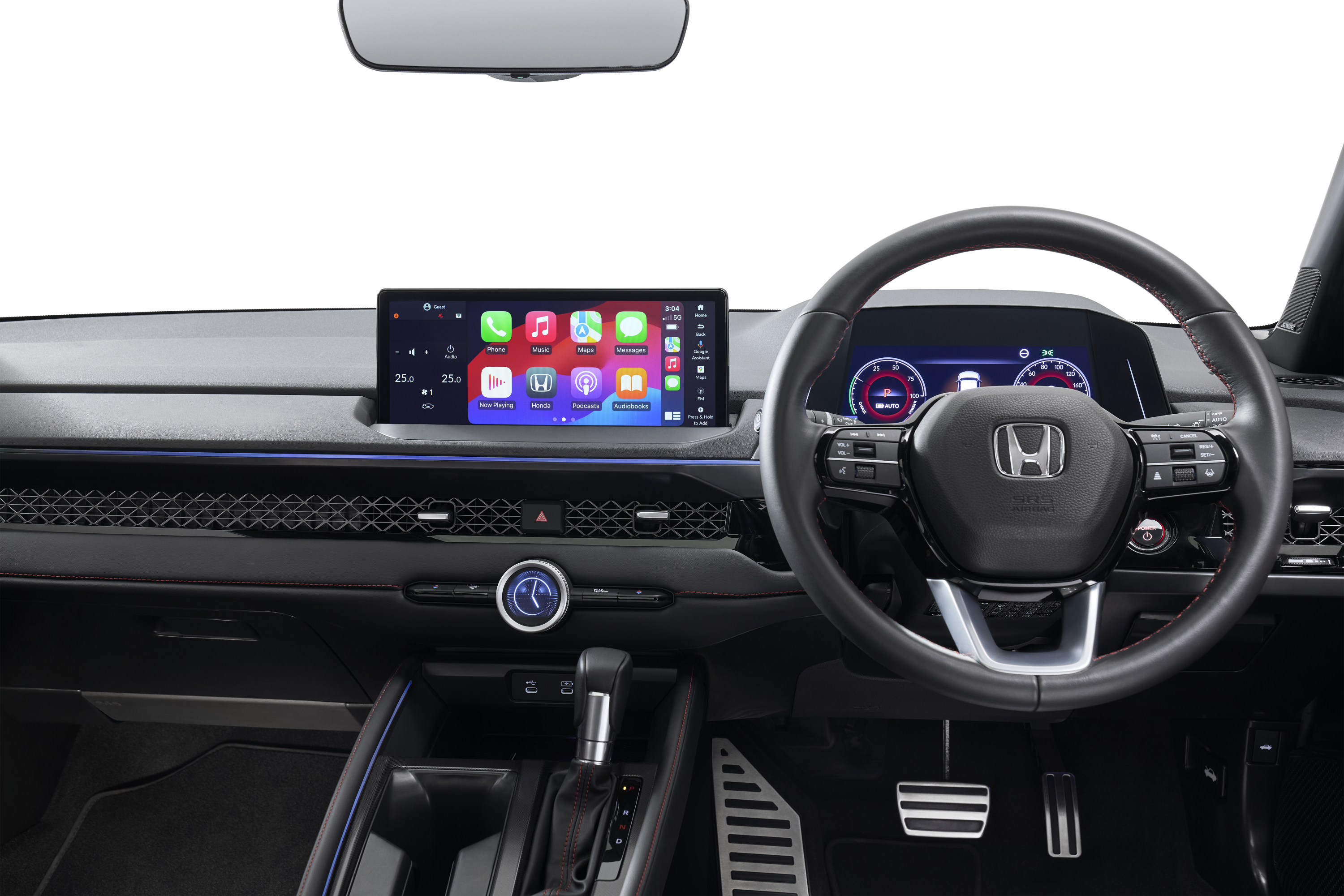
The 2024 Honda Accord E:HEV RS continues with a higher-than-usual price for a hybrid medium sedan, now at $64,900 drive-away – up $3000 over its predecessor.
This price includes all on-road costs – as has been the case since Honda’s switch to an agency dealer model in July 2021 – and equipment levels are pretty high, with some highlights shown in the table above.
A full specification run-down is available by clicking here.
While the $65,000 Accord does appear to be loaded with kit, it does lack some features, like heated/ventilated seats, a heated steering wheel, and a spare wheel (it has a tyre repair kit). It also omits the automatic parking feature fitted to the previous Accord.
Honda Australia executives have confirmed no plans for a lower-specced Accord as the car acts as a flagship model for the brand with low sales potential.
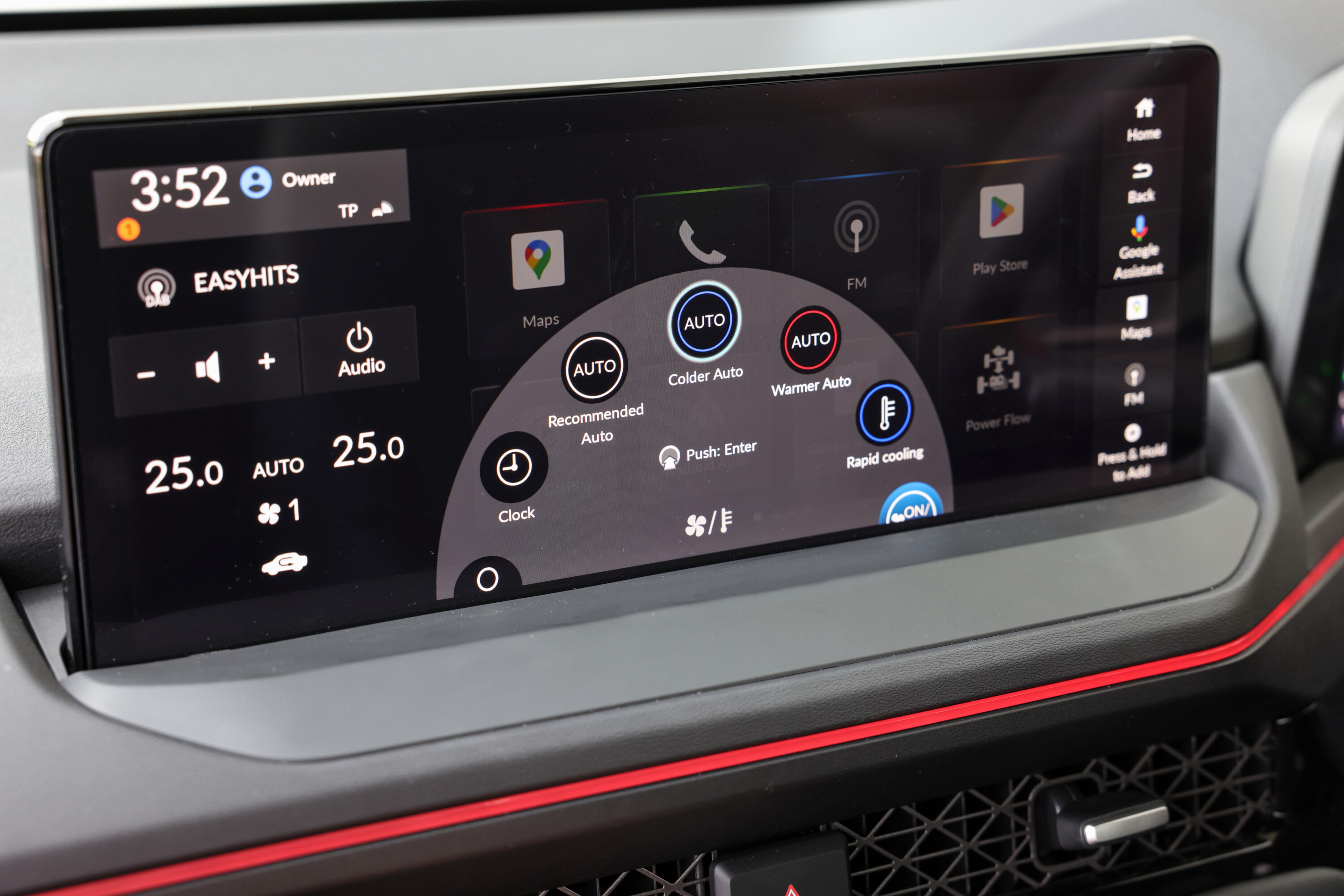
It’s a sensible decision given the shrinking customer demand in this segment – and we’re not product planners crunching the numbers – but could there still be room for a cheaper variant similar to Thailand’s ‘E’ or ‘EL’ in the low-to-mid $50K region?
Toyota Camry Hybrid order holders who have been waiting in the queue for months on end but can’t stump up the extra cash for the Accord RS come to mind here.
We think most people could live without some of the RS niceties, like the 18-inch alloy wheels (go 17-inch, instead), adaptive high beam, panoramic sunroof, Bose audio system, sequential indicators, door handle illumination, auto tilt-down side mirror, dark headliner and rear lip spoiler.
The Accord is available in four monochrome colours, all at no added cost: Platinum white, lunar silver, meteoroid grey and crystal black.
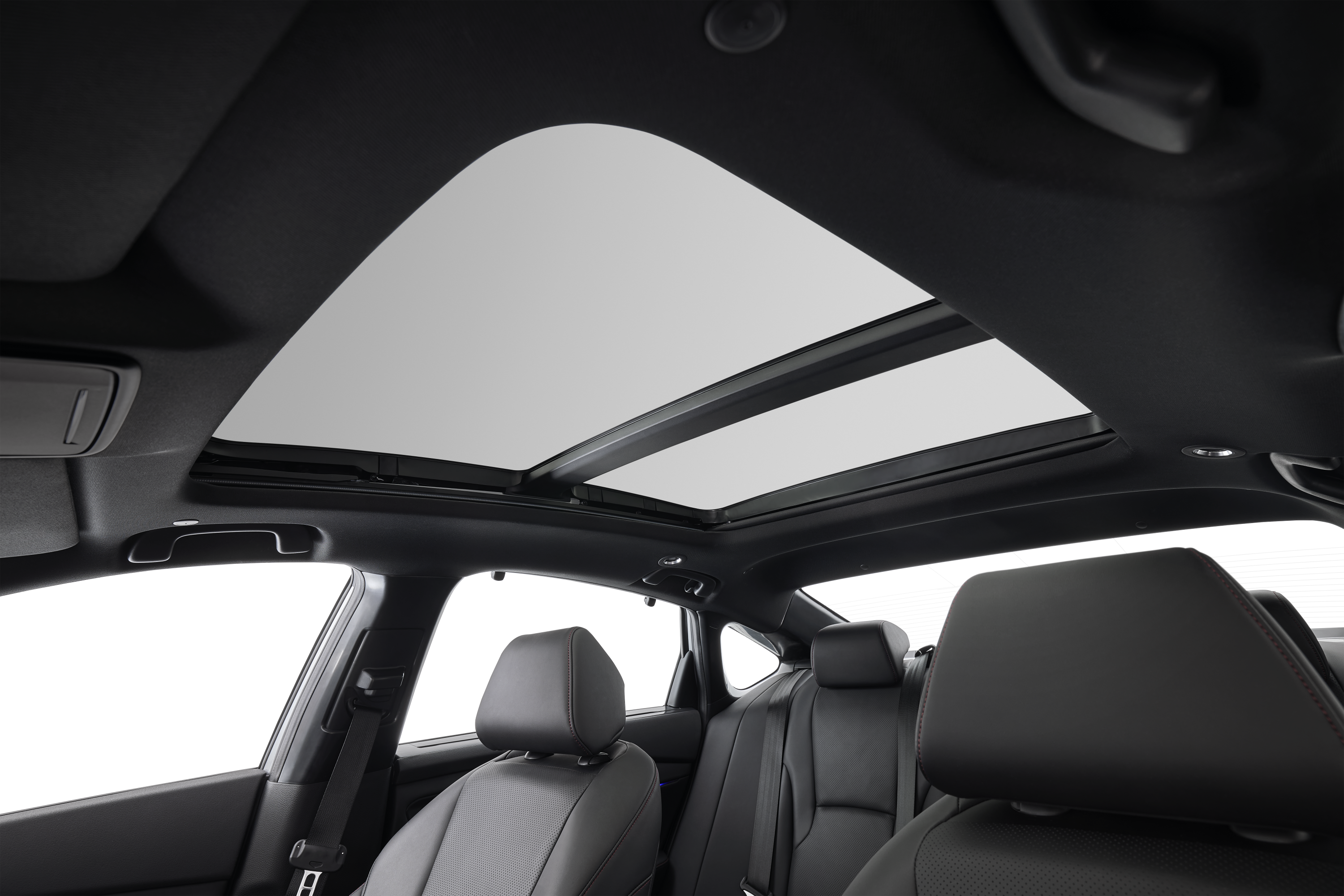
Where is this model in its lifecycle?
The 11th-generation Accord was unveiled for North America in November 2022. Right-hand drive versions continue to be sourced from Honda’s factory in Thailand, which also builds the CR-V midsize SUV for our market.
Honda Australia attributed the delay between North America and the Asia-Pacific to a separate model lifecycle between the two versions, as the last Accord launched in 2017 but didn’t arrive in the Asia-Pacific until 2019.
Asia-Pacific versions of the new Accord have a unique dashboard with the ‘Experience Selection Dial’ to control some air-conditioning and audio functions, a more prominent ambient lighting strip, and a floating-look digital instrument cluster.
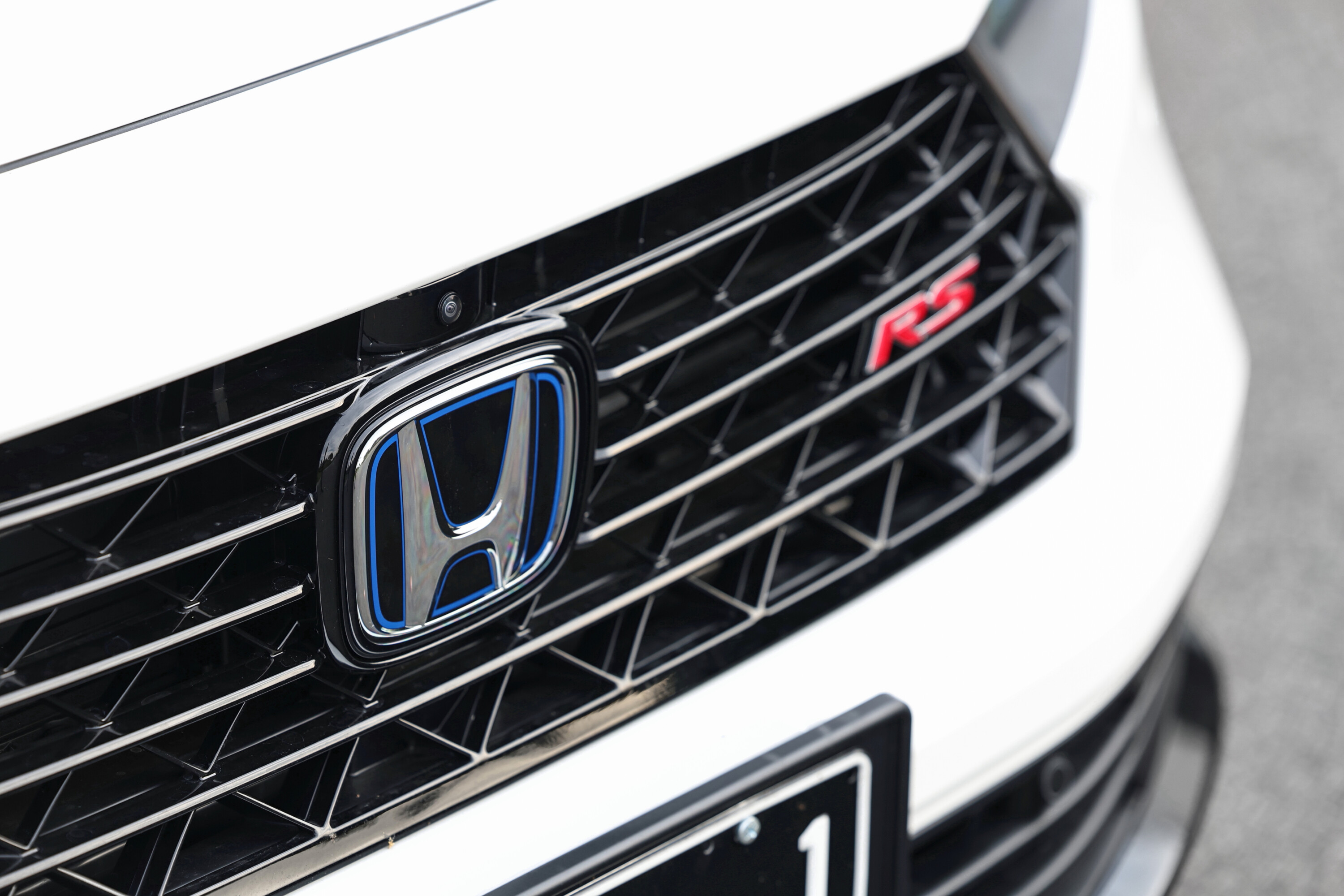
How do rivals compare on value?
Rivals to the Honda Accord include the Toyota Camry, Mazda 6, Skoda Superb and Lexus ES, or electric alternatives like the Tesla Model 3 and BYD Seal.
The Camry has long been the Accord’s arch-rival, with the soon-to-be-replaced hybrid line-up – currently unavailable to order due to extended wait times – priced between $37,917 and $51,417 before on-road costs.
A price rise is expected for the 9th-gen Camry due in the second half of the year, so the Accord should stack up a little better on value once Toyota’s newest hybrid sedan lands.
For context, a current top-spec SL costs around $8000 less than the Accord in most states when on-road costs are included, but the Accord’s price gap is widened further as most choose the Ascent or Ascent Sport base models.
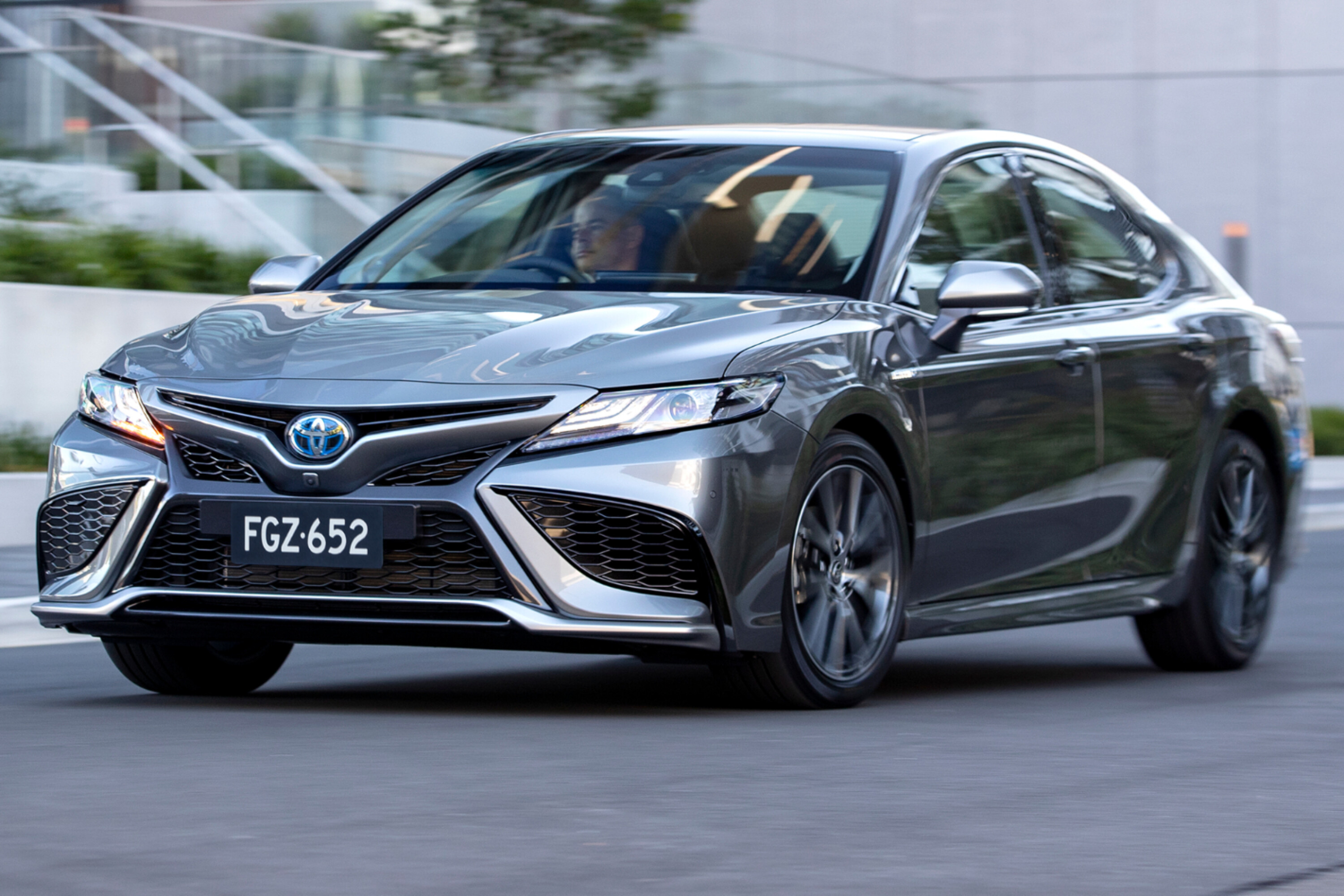
If you’re looking for a little more performance, the turbocharged Mazda 6 G35 Atenza sedan costs $52,590 before on-roads. It’s nicer to drive, but high fuel consumption and vintage tech let it down.
There’s also the recently-facelifted Hyundai Sonata N Line to consider for $55,500 before on-roads, or the Skoda Superb 206TSI Sportline liftback for $69,990 drive-away.
(VFACTS lists the Superb in the one-size-up large category, but the Accord is longer – even once the bigger next-generation model lands here in 2025. It’s considerably larger than the Skoda Octavia liftback, despite both vehicles sitting in the medium segment.)

The Lexus ES300h – the Camry’s premium sibling – is available in Luxury form for $65,540 before on-road costs, but you’d need to look at the $80,170 Sports Luxury to match some of the Accord’s features.
Full-electric cars can be had for the same price as the Accord, with the Tesla Model 3 Rear-Wheel Drive ($58,900 before on-roads; 513km WLTP) and BYD Seal Premium ($58,798 before on-roads; 570km WLTP) logical alternatives for buyers willing to consider making the next step.
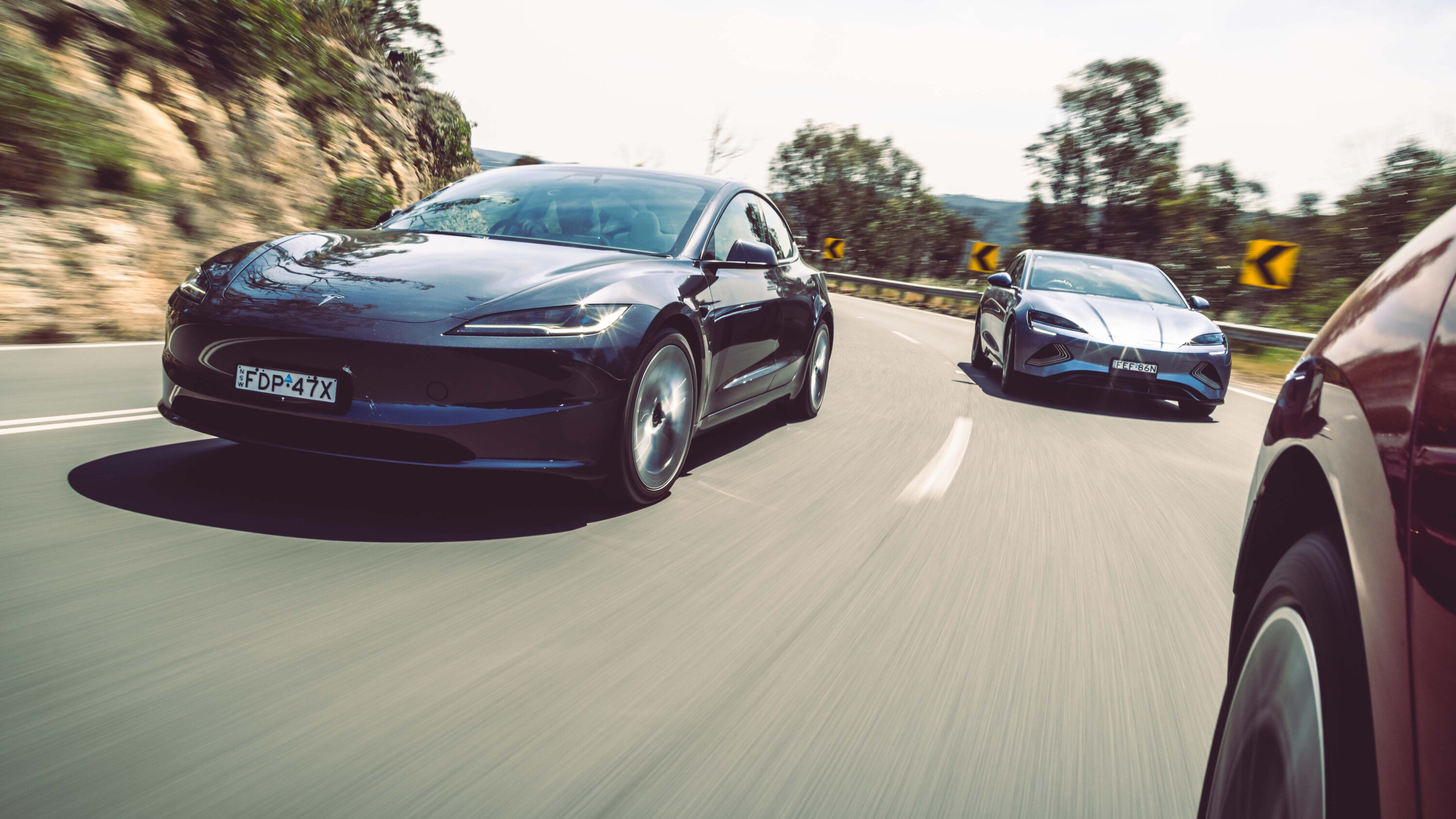
Interior quality, comfort, space and storage
The interior quality of the Accord feels on par with the Mazda 6, and a step above the Camry, with soft-touch materials in the front and rear, and a sturdy door thunk.
Build quality appeared solid in our short time with the Accord, apart from a rattle between the sunroof and overhead storage box.
The seats – clad in black leather upholstery with red stitching – were comfortable and supportive on a two-hour test drive, though they could be a little softer and lack heating or cooling functions.
Both front seats offer eight-way power adjustment, with the driver’s seat adding four-way power lumbar support and two-position memory, and rear occupants can control the passenger side for a chauffeur-like experience.
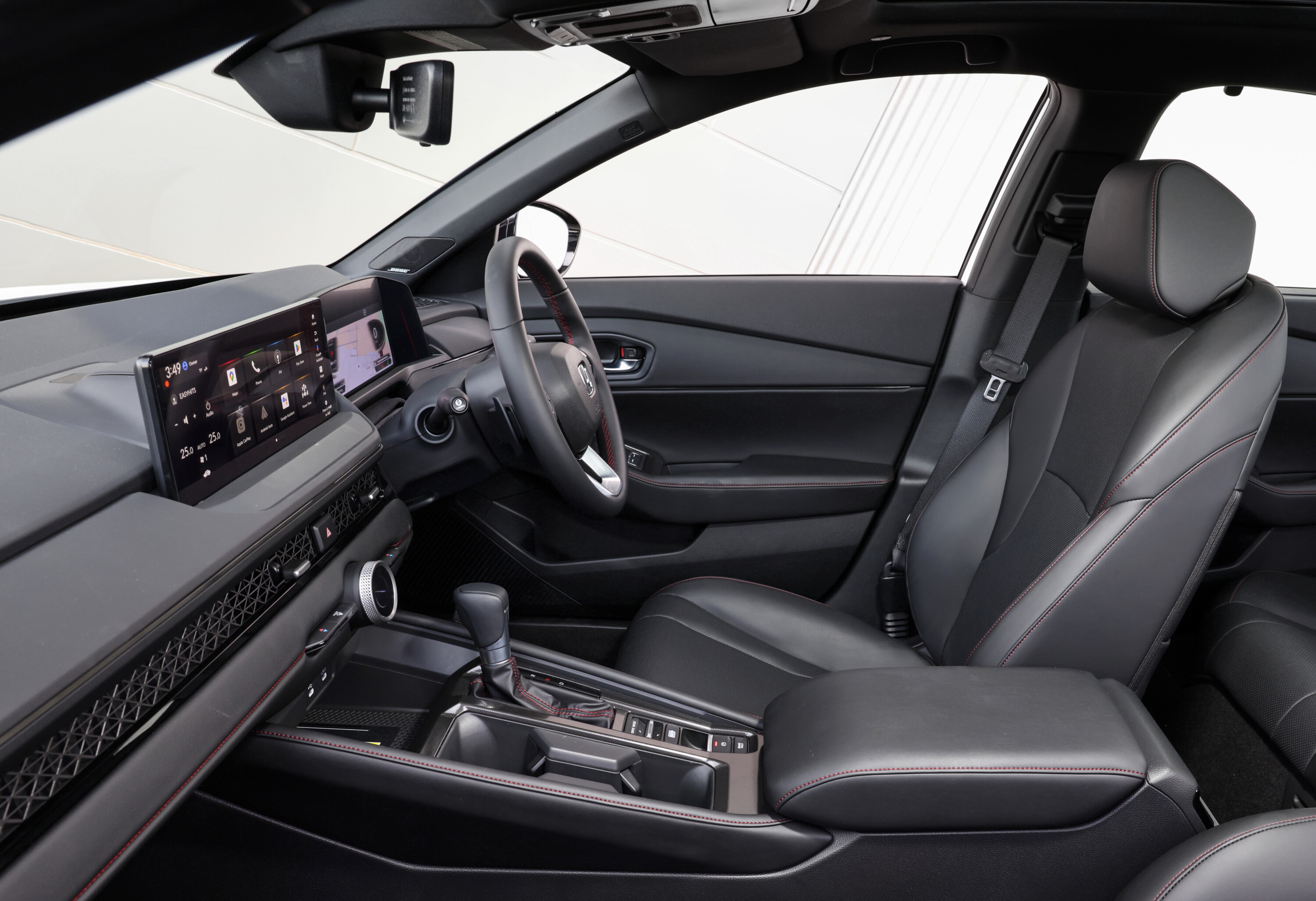
There’s a deep centre console storage bin, but the bottom isn’t padded, and there are no dividers, so smaller items like keys or garage door openers can slide around.
A nice touch is Honda’s honeycomb mesh-look air vents, a trend that started with the Civic, which are distinctive and allow for more directional control.
The deep cupholders are large enough to accommodate one-litre bottles, and the twin central holders have teeth to prevent smaller cups from sliding around.
The rear leg and toe room are generous, but headroom is tight for taller occupants due to its panoramic sunroof and sloped roofline. Amenities include manual sunshades, air vents, two seatback pockets, and a fold-down centre armrest with cupholders.

Boot space
The 2024 Honda Accord has a 570-litre boot capacity, which can be further extended with the rear backrest folded down. There’s no 60:40 split-fold, unlike most of its rivals.
As with the Camry, the Accord’s gooseneck hinges don’t fold into tunnels like a Sonata, leaving the risk of squishing items when the boot is overpacked.
The boot lid is nicely damped, opening from buttons on the rear, key fob or in the cabin, but it is not equipped with electric hinges to remotely close it.
Mini matchup: Boot space
| MODEL | WHEELBASE | BOOT |
|---|---|---|
| Honda Accord E:HEV RS | 2830mm | 570L |
| Toyota Camry SLu00a0 | 2825mm | 524L |
| Mazda 6 G35 Atenza sedan | 2750mm | 474L |
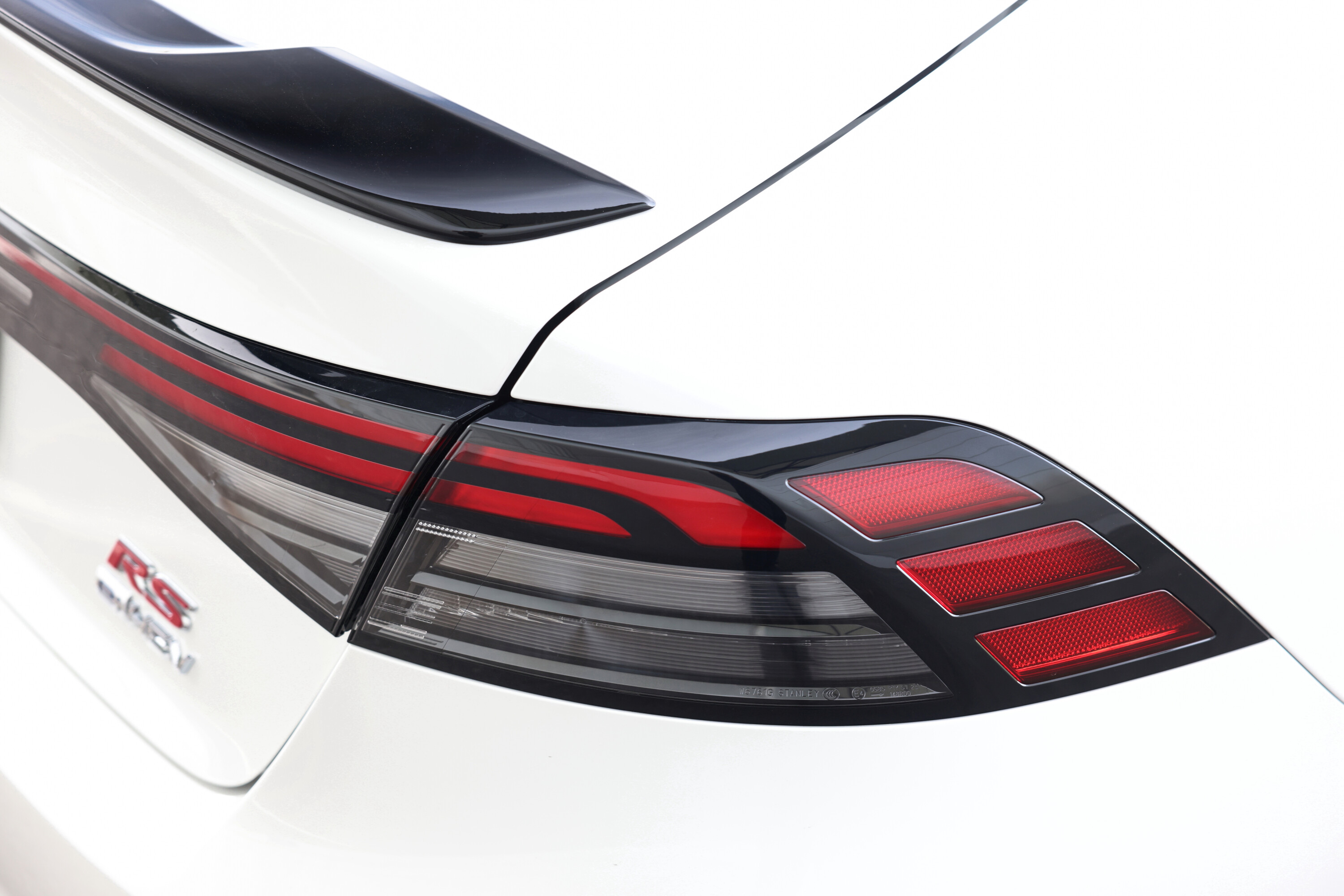
Technology in the cabin
It’s almost as if Honda has skipped a generation of Accord; such is the abrupt technological leap compared to the previous model.
In-car tech is the centrepiece of the new Accord, headlined by the sizeable infotainment system, Google Built-In services, ‘Experience Selection Dial’, and enhanced Honda Connect telematics with an in-car Telstra 4G/5G SIM card.
The larger 12.3-inch touchscreen – up from 8 inches – runs on Android Automotive with features like Google Assistant, Google Maps, and third-party app downloads from the Play Store.
Google Assistant works with the car’s hardware and is especially handy for making quick, simple changes like adjusting the climate control, setting a new destination, or even remotely controlling your garage door or lights when paired with an account with linked smart home devices.

Wireless or wired Apple CarPlay or Android Auto remain available, but the built-in technology means you could almost live without it, mainly if you use Google Maps and Spotify or YouTube Music.
You’ll need to use CarPlay or Android Auto for other popular services like Apple Music or Waze since you can’t download them onto the car from the Play Store – but more apps are likely to become available soon.
We found the wireless Apple CarPlay connection and inductive charger to work flawlessly paired to an iPhone 15 Pro, albeit with some audio dropout when passing toll road gantries – as seen in nearly every car with wireless phone mirroring.
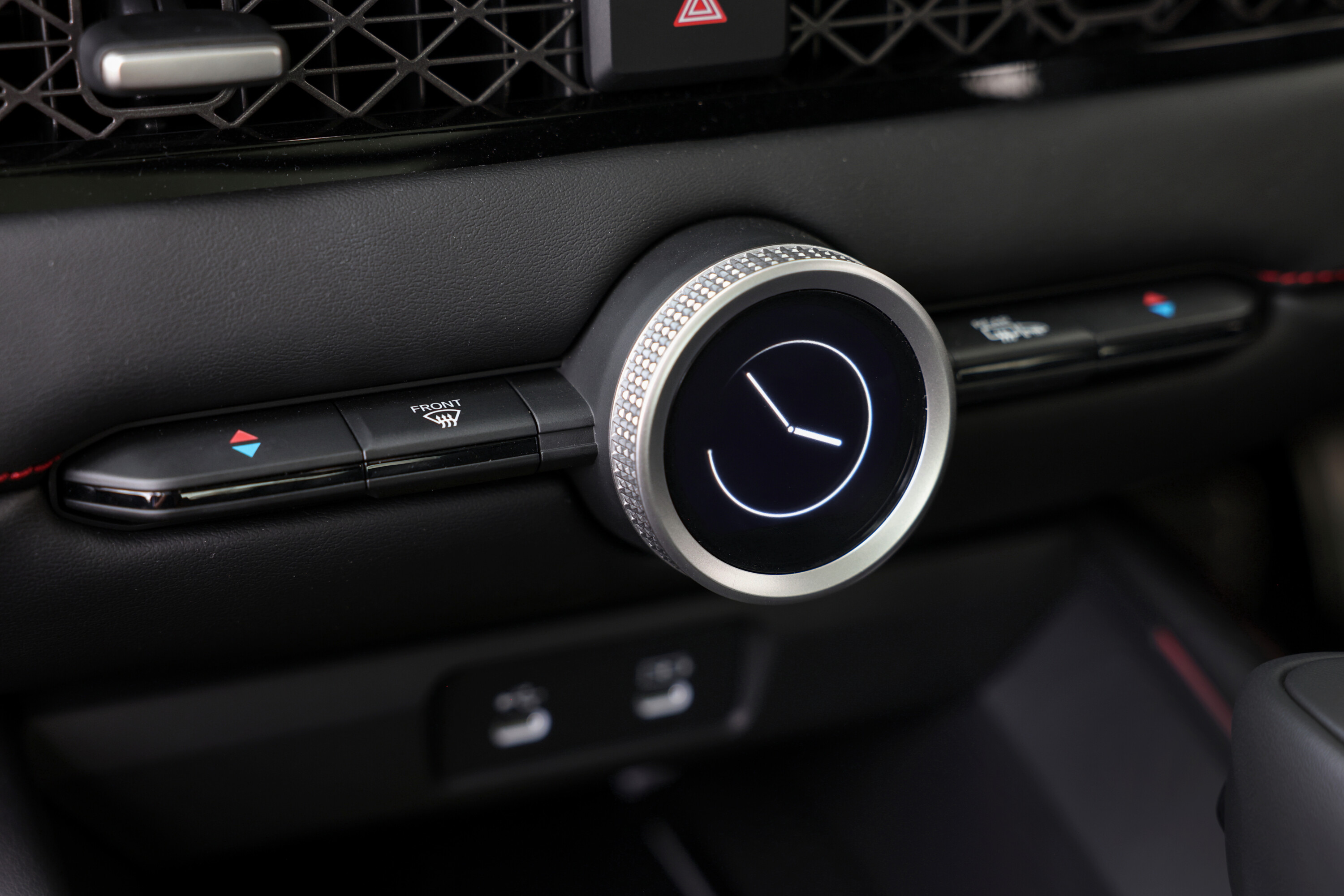
Another highlight is the nifty ‘Experience Selection Dial’ – similar in concept to the ‘Smart Dials’ coming to the new Skoda Superb – which has a circular display with a digital clock as default but provides quick controls for the air-conditioning and driver profiles when turned.
We’d still like to see physical volume and power/tuning knobs retained, as these have moved to the touchscreen without any haptic feedback.
Honda Connect, which is complimentary for the first five years, has been updated for the Accord with a digital key function – requiring its own app, unlike the seamless Tesla or BMW connections – and a remote immobiliser to track the car and prevent the original key from being used if it is stolen.
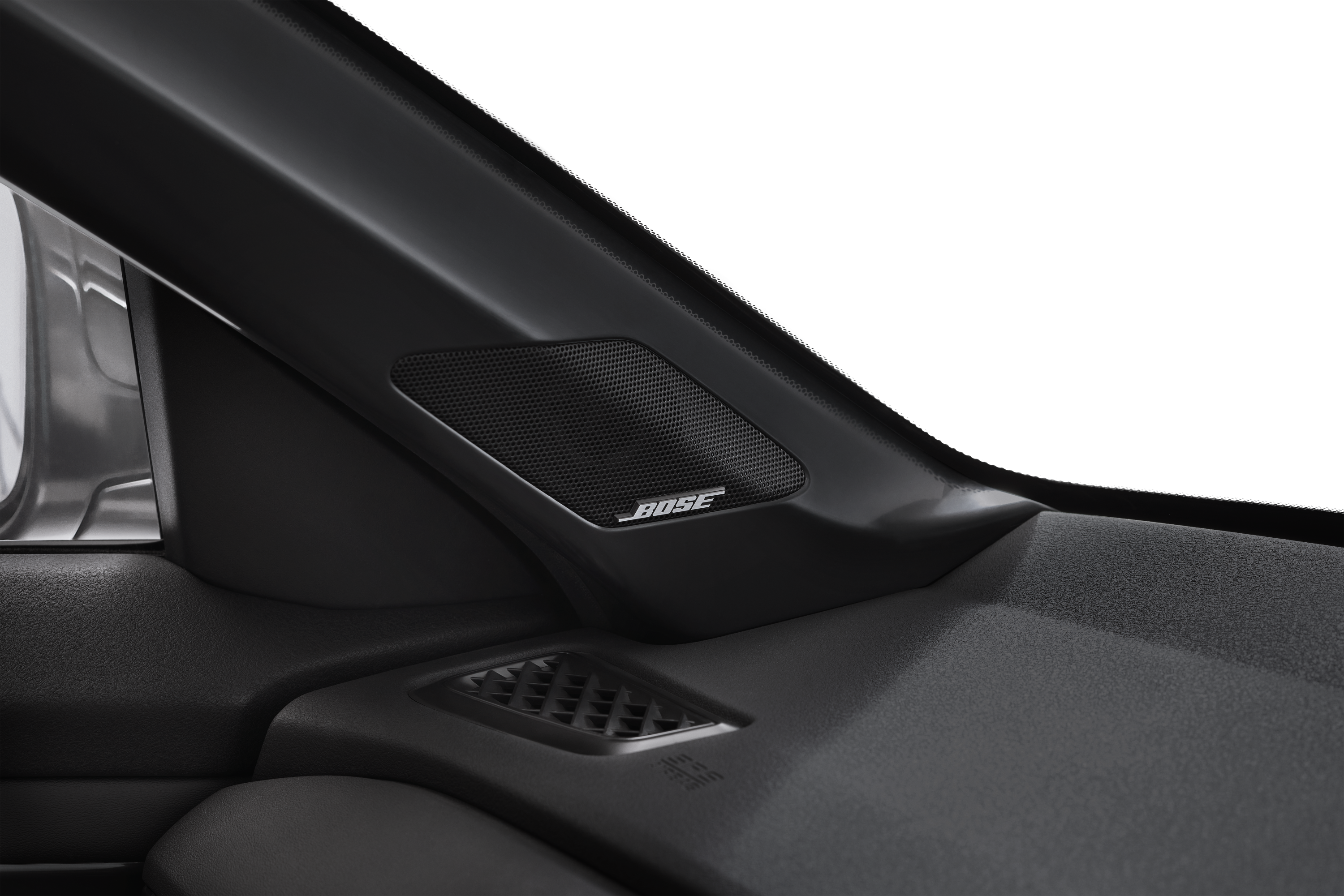
In addition, the time to remote start from the Honda Connect app is almost instantaneous, compared to the circa-30-second wait in other models like the Civic Hybrid and CR-V. You can also remote start from the key fob, as before.
Other features in the Accord’s cabin include an expansive 11.5-inch colour head-up display – more than twice the size of the previous version – and 10-colour configurable ambient lighting that provides a cool ambience at night.
Rear-seat passengers are treated to twin USB-C charge ports, while the ambient lighting extends to the rear doors and footwells.
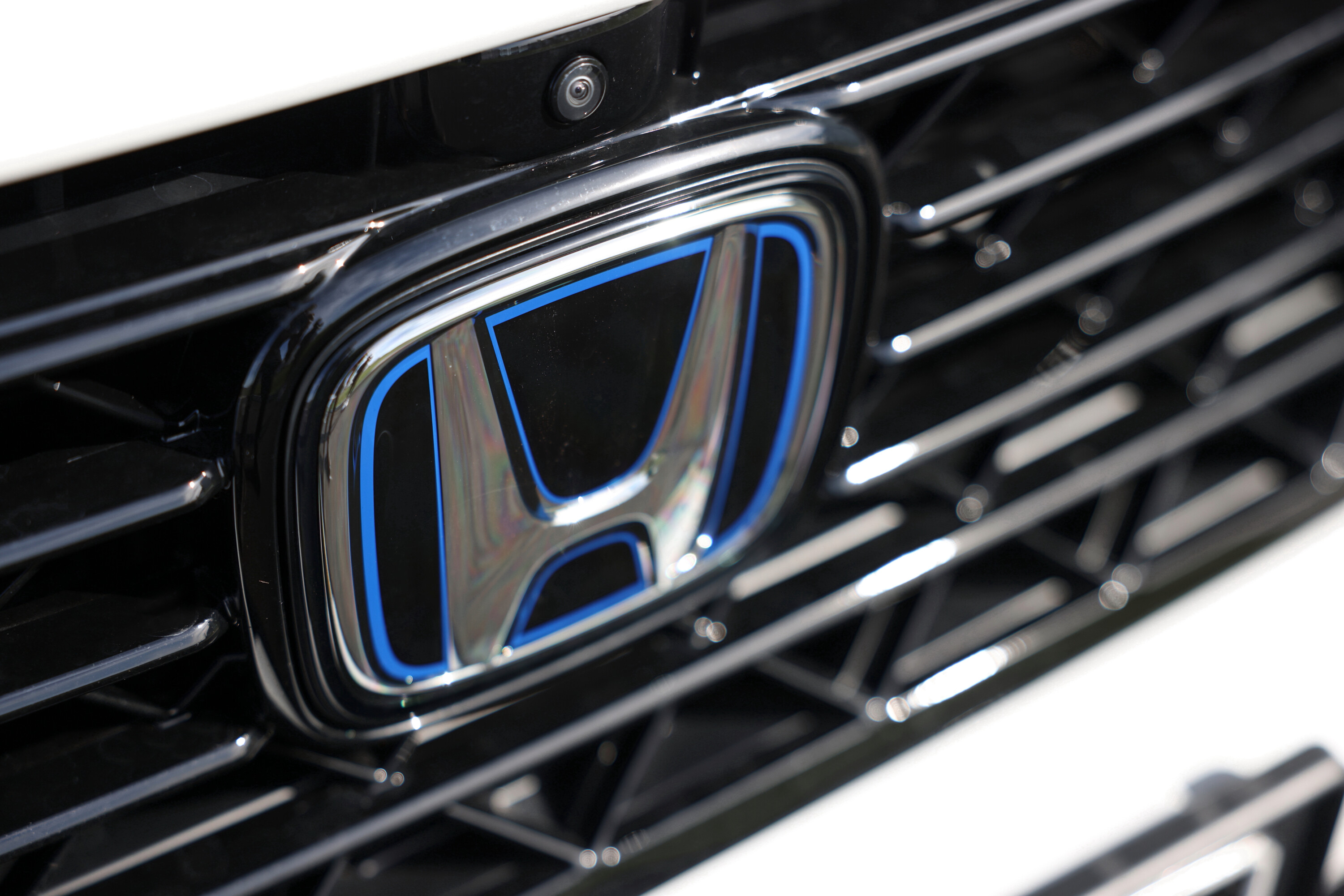
What is it like to drive?
Press the start/stop button and the Accord quietly comes to life, operating in EV mode (unless it’s a cold morning or hot afternoon or the battery is low) and playing a pedestrian alert sound at low speeds.
You’re unlikely to hear much of the internal combustion engine, with the traction motor doing all the work until the battery needs to be recharged, during strong acceleration, or when driving at higher speeds.
Shared with the CR-V, the Accord’s fourth-generation hybrid system comprises a 108kW/182Nm 2.0-litre Atkinson-cycle naturally-aspirated four-cylinder petrol engine, a lithium-ion battery, and two electric motors – a 135kW/335Nm traction unit and a dedicated generator to charge the battery – now mounted side-by-side.
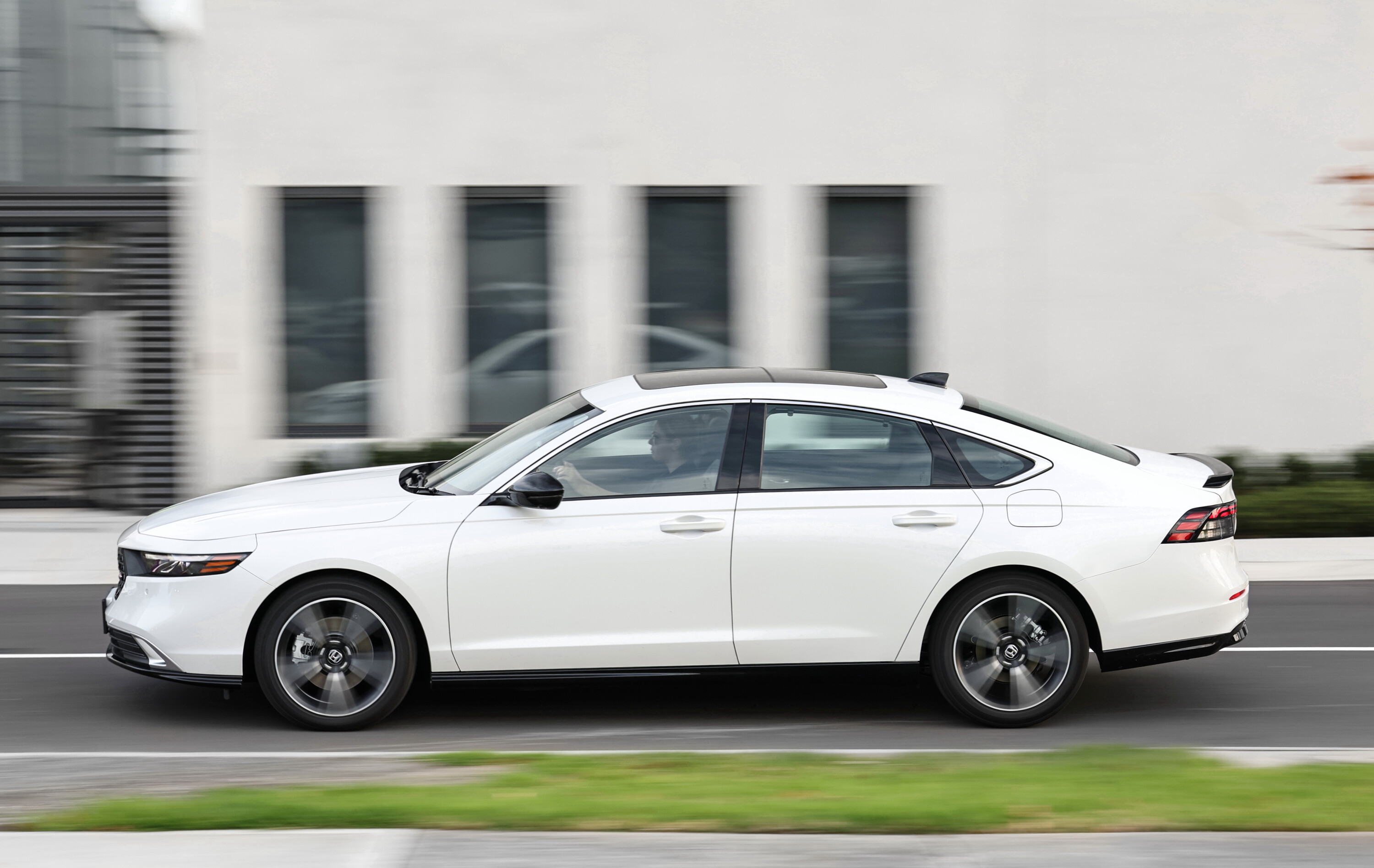
Unlike Toyota vehicles, which mostly operate as a parallel-hybrid, or Nissan E-Power vehicles, which only operate as a series-hybrid, the Honda system can work as either a series or parallel hybrid.
The Accord is usually a series-hybrid – the petrol engine doesn’t power the wheels – but a lock-up clutch can allow additional torque from the petrol motor to be directly sent to the wheels at higher speeds, bypassing the generator motor.
While the 135kW (@ 5000-8000rpm) output appears lower than the old 158kW model, Honda says there is a “refined power calculation method”, claiming it would be identical to the old model using the same calculations but now available across a wider rev band. Torque has increased 20Nm to 335Nm (@ 0-2000rpm).
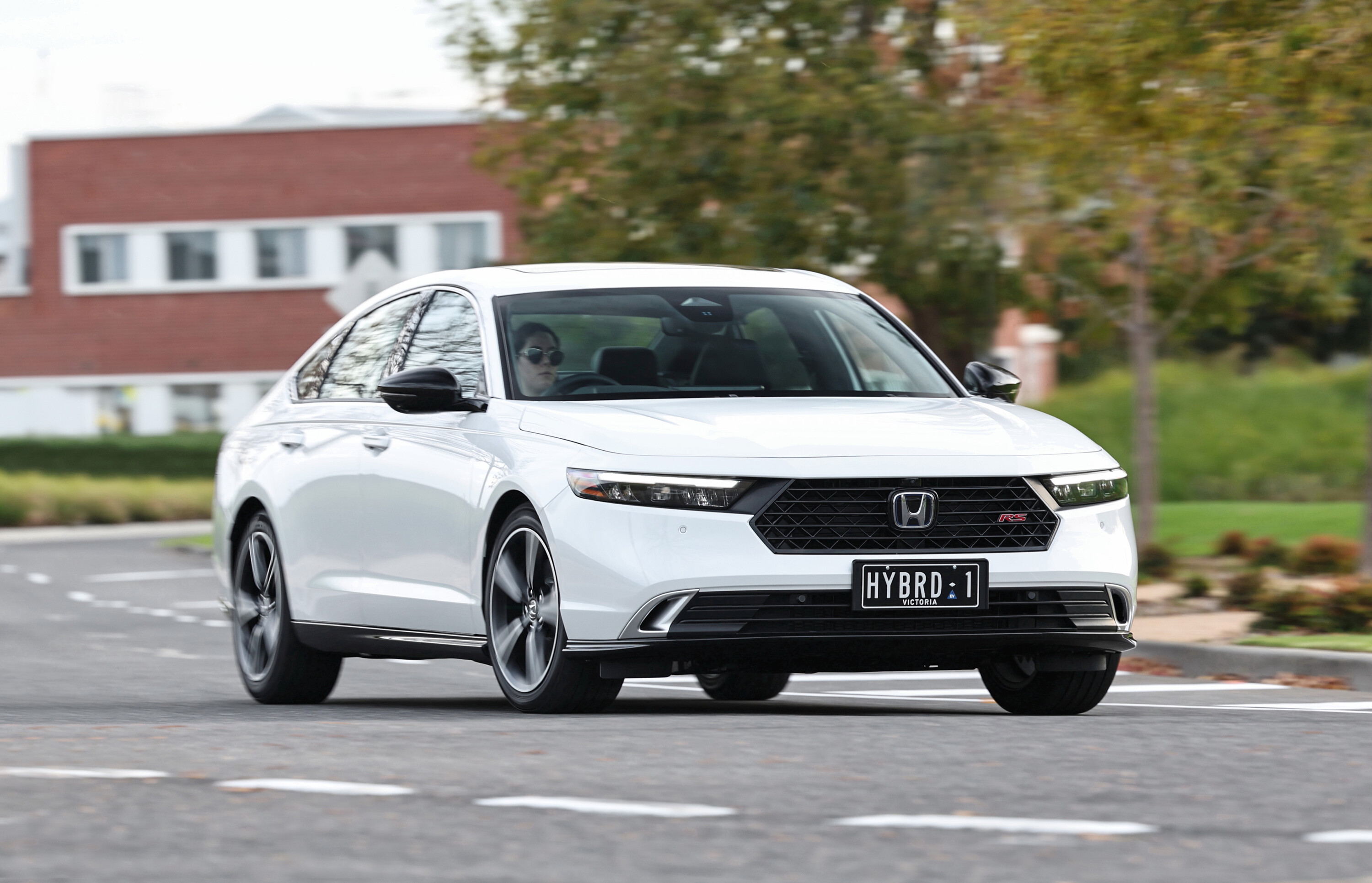
On the road, the Accord E:HEV is a smooth operator. It’s quiet and refined – even when the petrol engine is running – with a well-calibrated electric continuously variable transmission that mimics traditional gear shifts and little road noise.
Honda has blended a comfortable ride with a confidence-inspiring steering feel with minimal body roll and a clear turn-in, assisted by the grippy Michelin E-Primacy tyres.
There’s a natural-feeling brake feel in town and at higher speeds, with support for six levels of deceleration using the steering wheel-mounted selector paddles, allowing a one-pedal-like driving experience in the strongest setting.
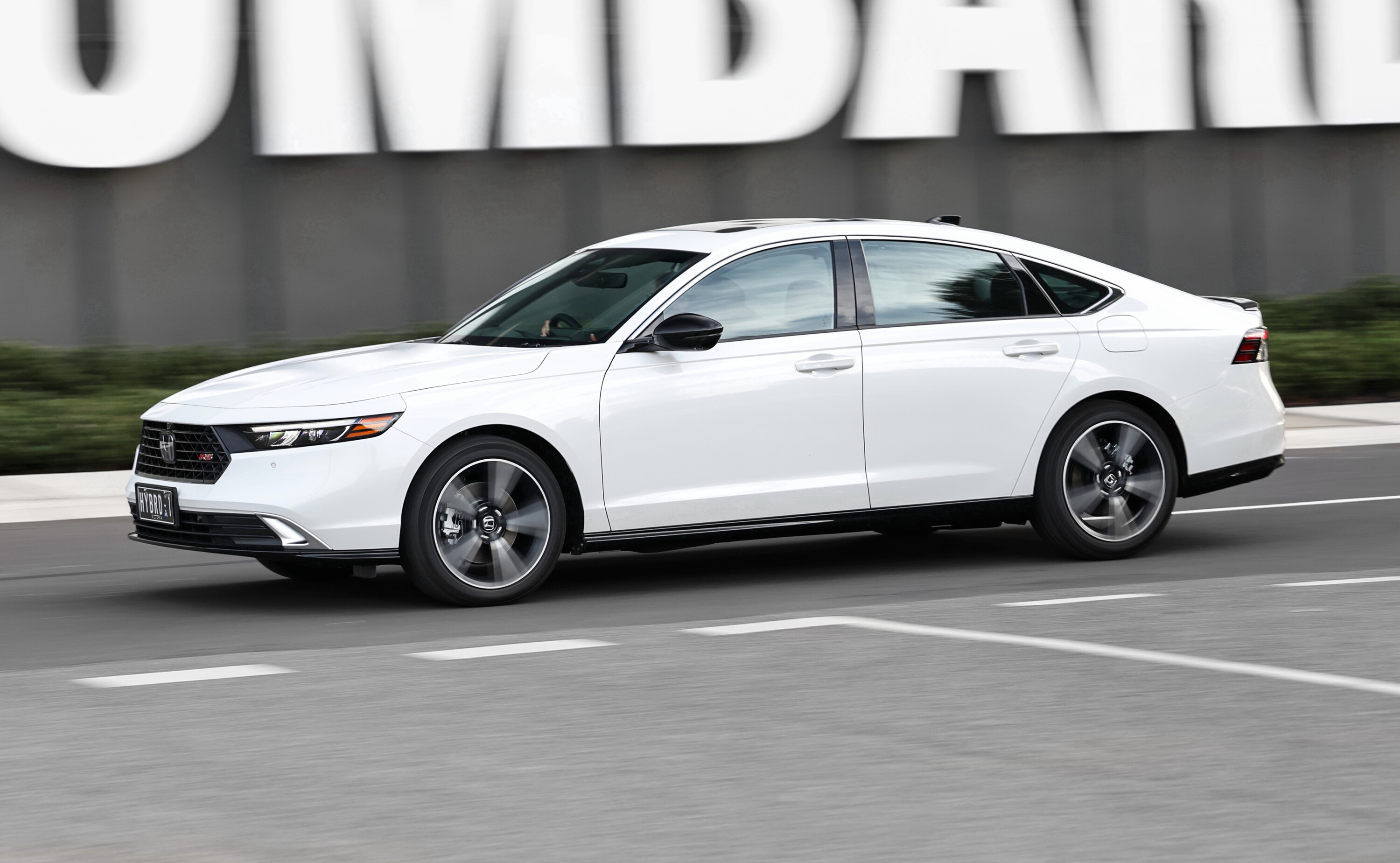
Four drive modes are available – econ, normal, sport or individual – while it’ll automatically switch between ‘EV’, ‘hybrid’ or ‘charge’ depending on the driving condition.
The econ drive mode will limit throttle response and make the air-conditioning more efficient to reduce fuel consumption, while sport mode improves throttle response to reduce acceleration time and sends an artificial engine sound into the cabin.
We found the low-beam and the adaptive high-beam with active cornering function worked well in suburban areas with satisfactory illumination of the road ahead, though we were unable to test it in darker rural areas.
The latest Accord rides on an updated version of Honda’s Global Architecture, with a longer body at 4971mm – up 70mm – and an unchanged 2830mm wheelbase.
If any of the terms in this section have left you scratching your head, these articles will help bring you up to speed!
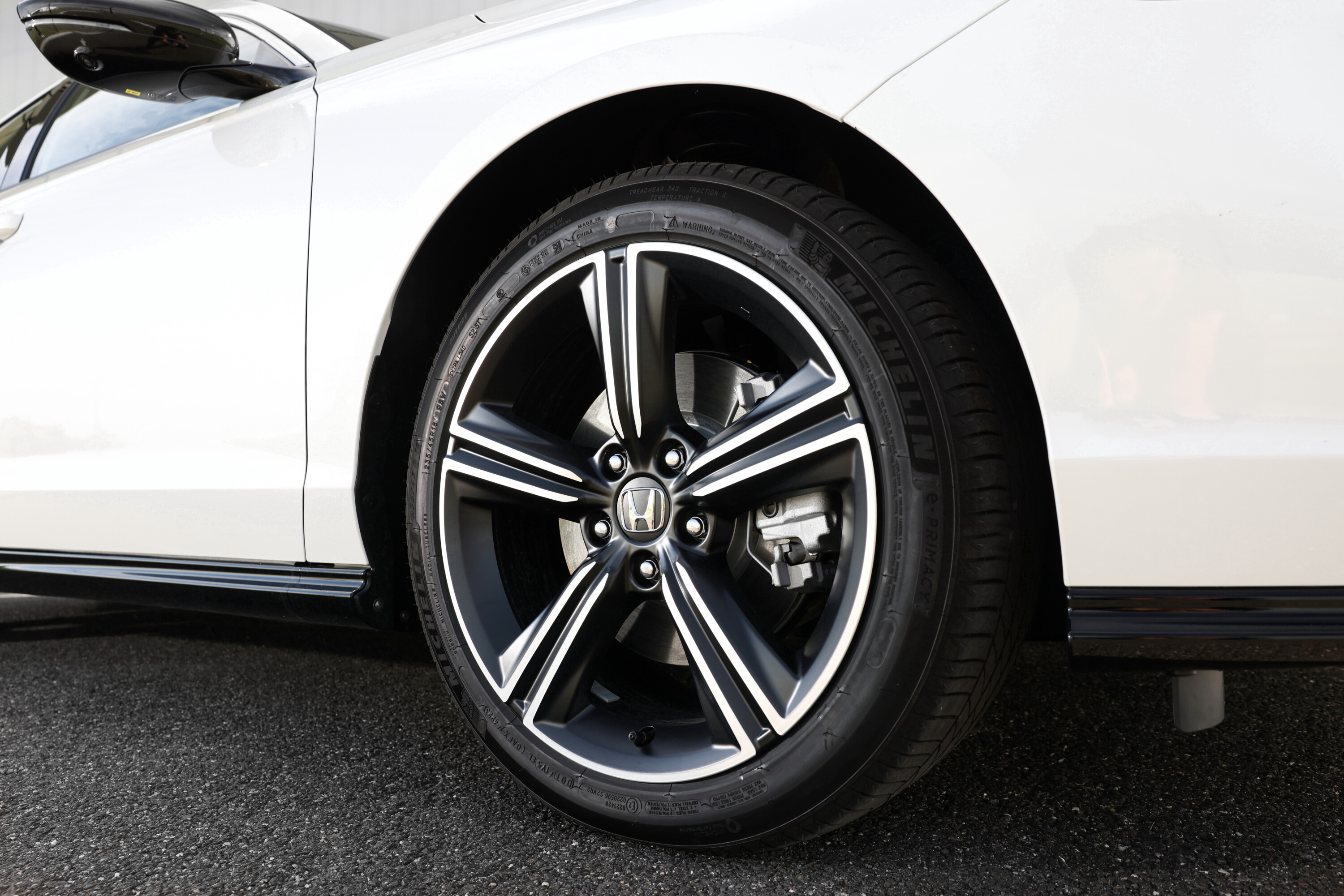
- What is a Powertrain or Drivetrain?
- Power vs torque
- Car suspension explained
- Automatic transmissions (‘gearboxes’) explained
- Chassis control systems explained
- Car vs Ute vs SUV: How the vehicle you buy should guide the way you drive
- What is the WLTP emissions and range test?
Claimed fuel consumption for the Accord E:HEV RS is 4.3L/100km on the combined cycle, 2.4L/100km in urban conditions, or 5.4L/100km in extra-urban environments.
A fuel top-up revealed our Accord averaged an incredible 3.8L/100km after 230 kilometres of driving on mixed roads (suburban, freeway and rural), while the car’s trip computer indicated 4.1L/100km. We only had our test vehicle for a 24-hour loan, so the result could differ if we drove it for a week or two.
With a 48-litre fuel tank and a 4.3L/100km combined consumption, it has a theoretical driving range of over 1000 kilometres. The Accord can be fuelled with 91RON unleaded, while the Camry Hybrid requires premium juice.
Mini matchup: Fuel consumption
| MODEL | MIN RON | COMBINED FUEL CONSUMPTION |
|---|---|---|
| Honda Accord E:HEV RS | 91 RON | 4.3L/100km |
| Toyota Camry SL | 95 RON | 4.5L/100km |
| Mazda 6 G35 Atenza sedan | 91 RON | 7.6L/100km |
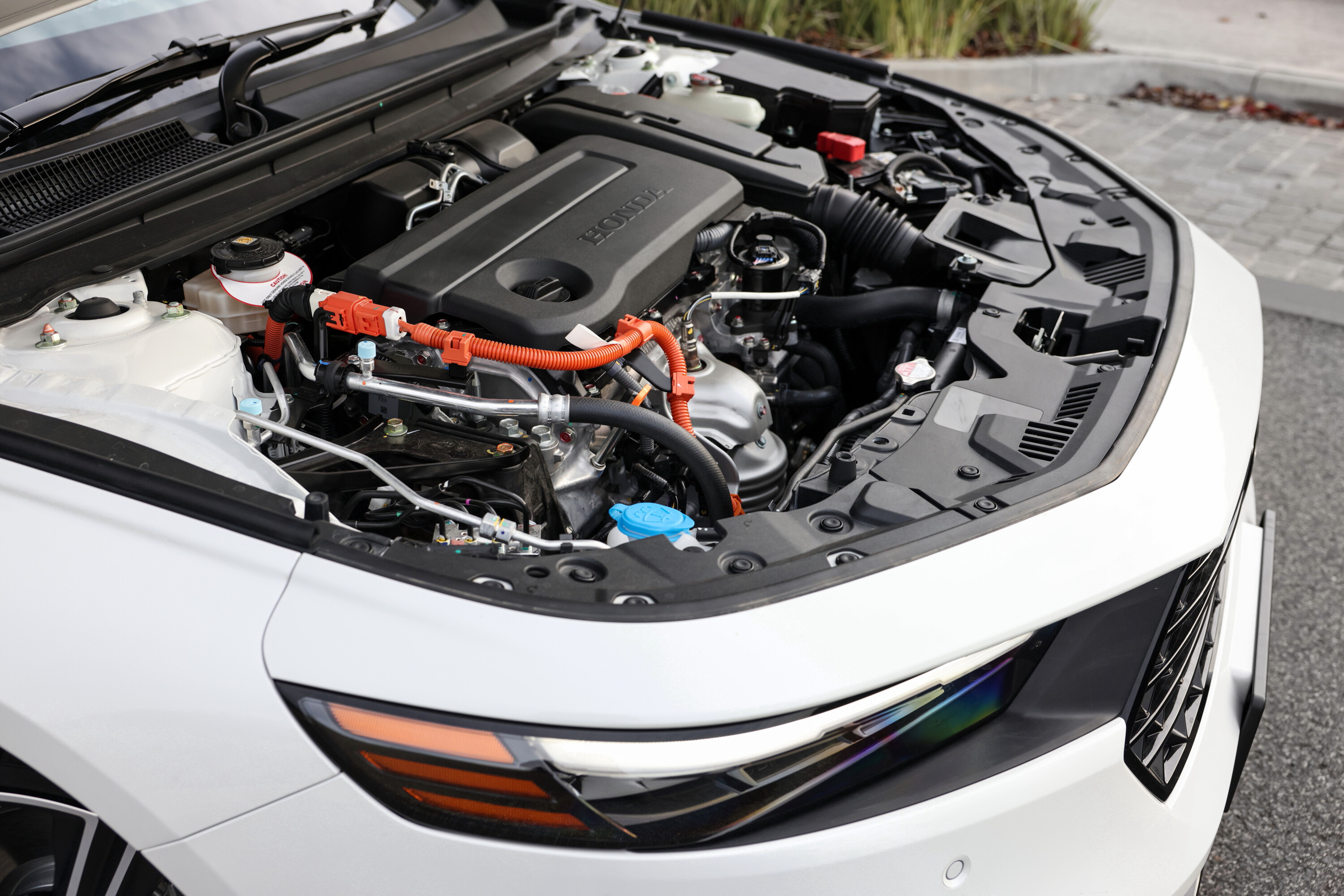
How safe is it?
Like its predecessor, the 2024 Honda Accord has not been assessed by ANCAP or Euro NCAP.
The Accord did score five stars from ASEAN NCAP (87.44 out of 100 points) and a 2024 Top Safety Pick+ award from the IIHS in the United States. However, both safety organisations operate under different criteria to ANCAP and Euro NCAP.
There is no front-centre airbag, intersection autonomous emergency braking (AEB) detection or driver monitoring camera often seen as features that help to score top marks under ANCAP’s 2023-25 assessment criteria.
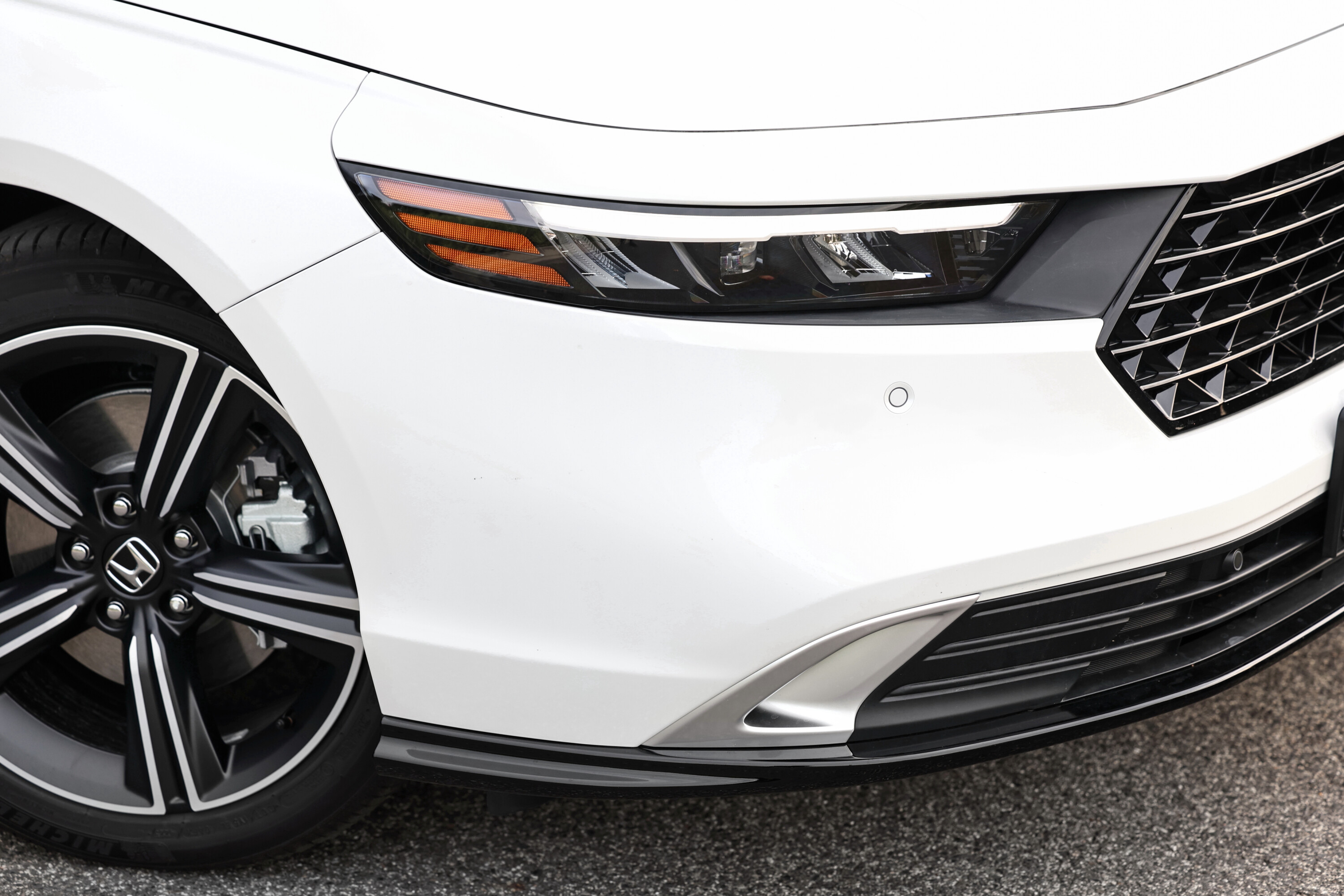
It still has plenty of safety inclusions that would likely earn a respectable score if it were tested by ANCAP, including eight airbags (dual front, side front, knee and full-length curtain), vehicle/pedestrian/cyclist/motorcyclist AEB, lane-keep assist, and a new pop-up bonnet for pedestrian protection.
We found the forward collision warning would react to some vehicles parked to the kerb – particularly where there was a slight curve in the road – though it never attempted to apply the brakes.
The traffic sign recognition – which appears in the head-up display – could not detect some visible speed signs, and it does not seem to fall back on data from the built-in maps when a reading is missed.
| 2024 Honda Accord E:HEV RS safety features | |
|---|---|
| Autonomous emergency braking (vehicle, pedestrian, cyclist, motorcyclist) | Traffic jam assist (new) |
| Lane-keep assist | Adaptive high beam (new) |
| Lane departure warning | Traffic sign recognition (new) |
| Blind-spot monitoring (replaces LaneWatch passenger-side camera) | Driver attention monitor |
| Rear cross-traffic alert | Rear seat reminder (new) |
| Adaptive cruise control | Front and rear parking sensors |
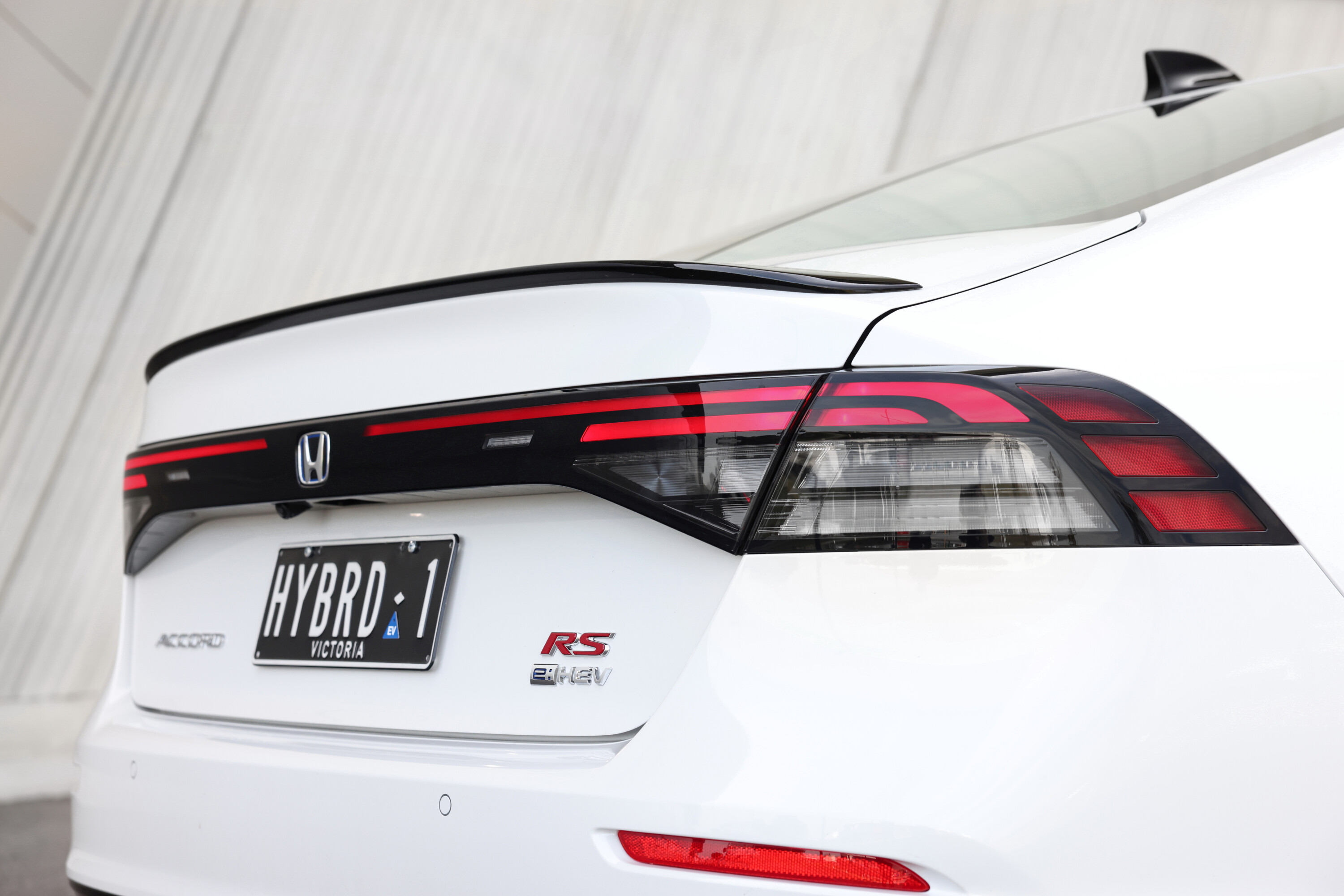
Warranty and running costs
Like other Hondas sold in Australia, the Accord is covered by an industry-standard five-year/unlimited-kilometre warranty.
While Honda’s shift to an agency model with fixed, no-haggle drive-away prices has been controversial, one benefit is five years of capped-price servicing at $199 per visit ($995 in total) – making it one of the lowest in the industry.
Over the same period, a Toyota Camry Hybrid would cost $1275 to service at the dealer, $1975 for a Sonata N Line, at least $2576 for a Mazda 6 G35, $2600 for a Skoda Superb 206TSI with a pre-paid package, and $2975 for a Lexus ES300h.
Maintenance is required every 12 months or 10,000 kilometres, whichever occurs first. This is lower than its mentioned rivals (except the Sonata), which allow 15,000 kilometres between each service – potentially impacting the savings if you average more than 10,000 kilometres each year, as most Australians do.
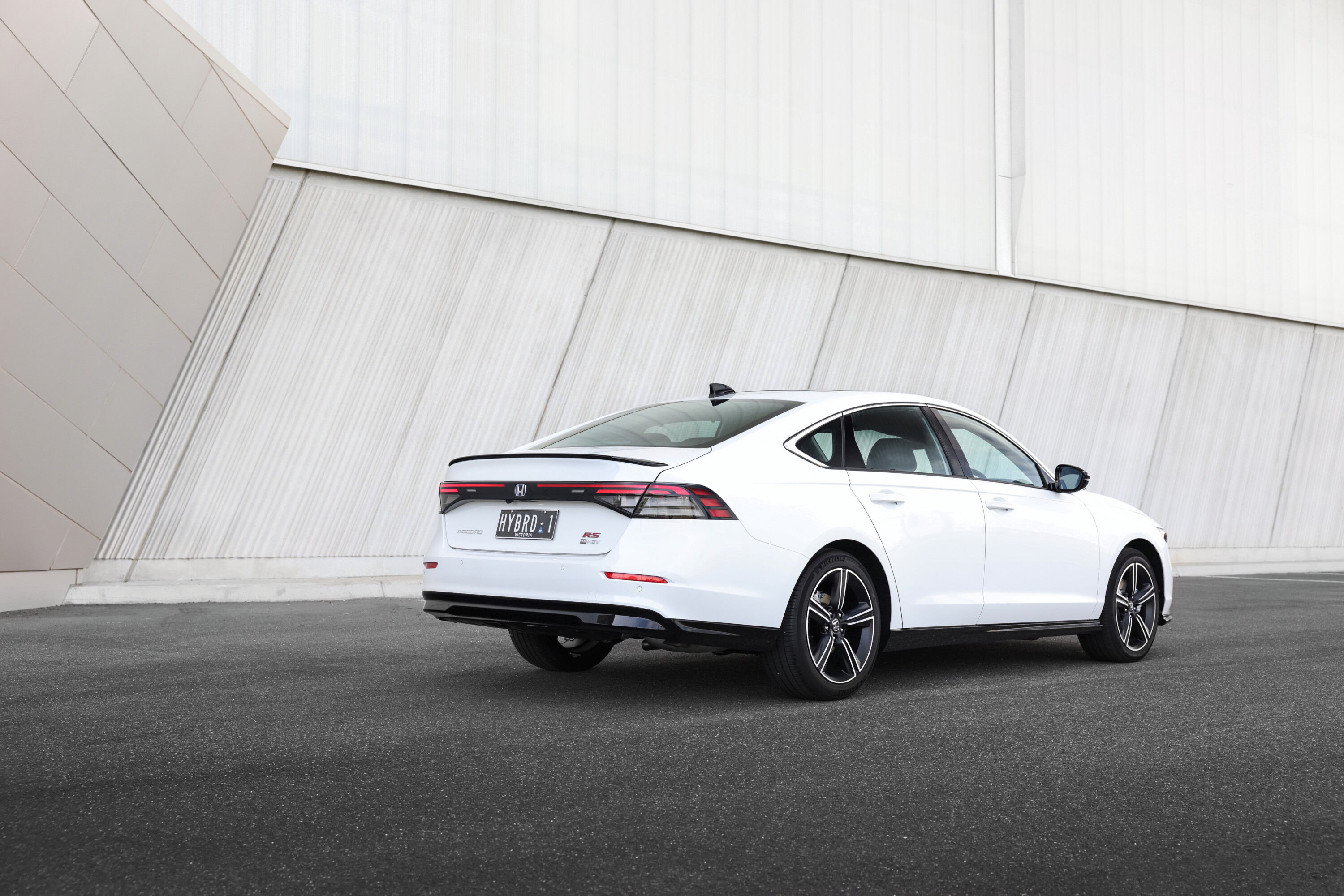
VERDICT
Honda’s mature Accord sedan enters its 11th generation still aimed at older buyers or rideshare drivers, but there’s some new-age tech and a fuel-sipping hybrid powertrain to broaden its appeal.
However, it remains let down by its high drive-away price, leaving it out of reach as a competitor for the best-selling versions of the Camry Hybrid – and squaring it up against full-electric alternatives like the Model 3 or Seal available for similar coin.
We’d love to see a more affordable Accord Hybrid in Australia that omits some of the RS’s desirable features, but Honda’s decision to import one variant does make sense, given it’s unlikely to sell more than a dozen units each month.
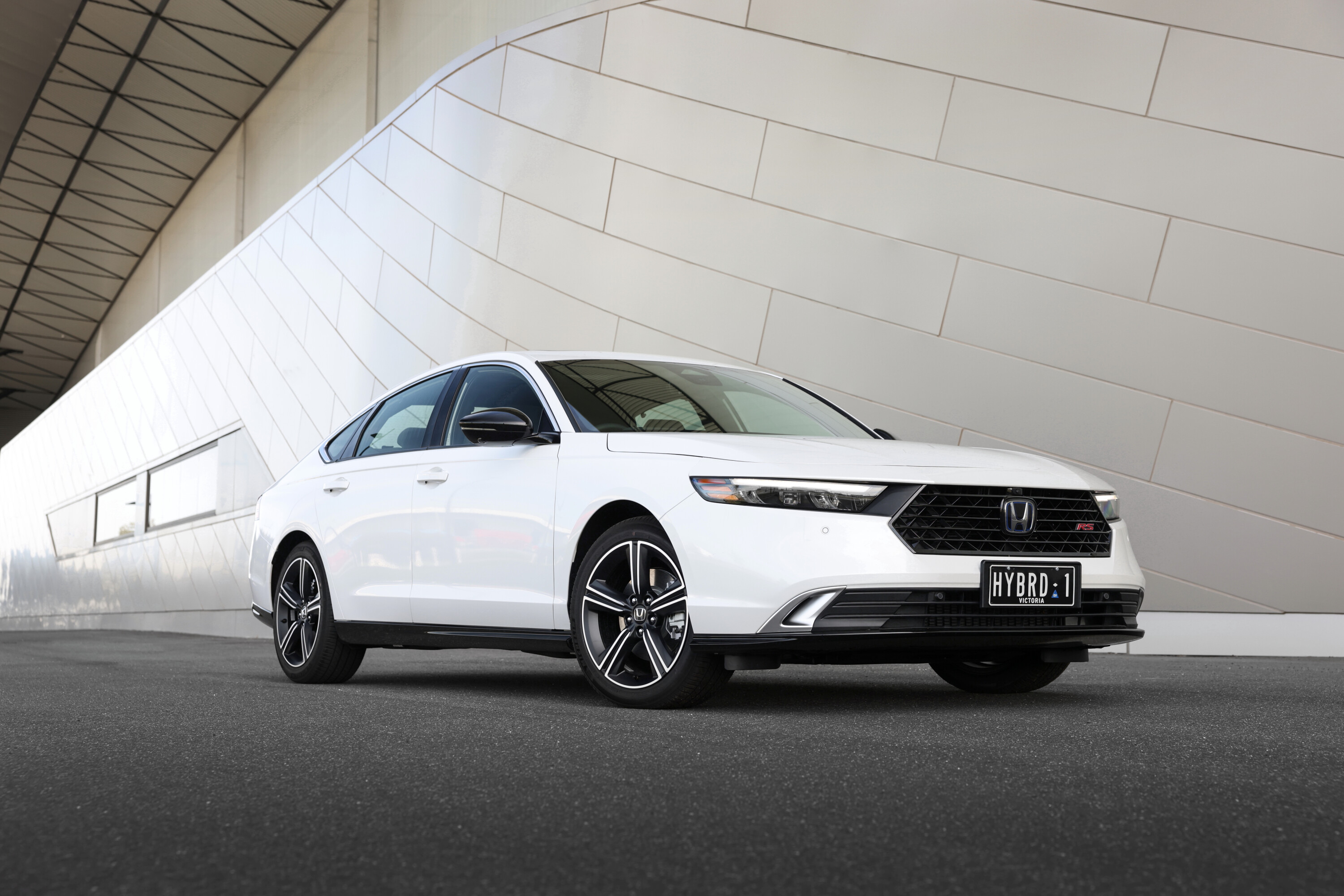
With its smooth and efficient hybrid powertrain, up-to-date technology, and strong practicality, the 2024 Honda Accord is worth shortlisting if you’re one of the few people in the market for something that isn’t a ute or SUV.
It’s especially worth considering if you’ve been impatiently waiting for your Camry order to arrive, as the Accord’s low sales volume means there’s every chance a car will become available much sooner.
| 2023 Honda Accord E:HEV RS hybrid | ||
|---|---|---|
| Engine | 2.0-litre naturally-aspirated petrol-electric hybrid | |
| Power @rpm | 135kW @ 5000-8000rpm | |
| Torque @rpm | 335Nm @ 0-2000rpm | |
| Transmission | Electric continuously variable transmission (E-CVT) | |
| Body | Medium sedan, four-door | |
| L/W/H | 4935mm/1862mm/1449mm | |
| Wheelbase | 2830mm | |
| Boot space | 570L | |
| Weight | 1585kg | |
| Fuel / tank | 91 RON / 48 litres | |
| Fuel use L/100km | 4.3L (claimed) | 3.8L (on test) |
| Suspension | Front: struts / Rear: multi-link | |
| Steering | Electric rack-and-pinion | |
| Brakes | Front: ventilated discs / Rear: solid discs | |
| Wheels | 18-inch diameter / 235mm width | |
| Tyres | Michelin E-Primacy | |
| Tyre size & spare | 235/45 R18, no spare (tyre repair kit) | |
Score breakdown
Things we like
- Efficient, smooth hybrid powertrain
- Up-to-date technology
- Spacious, practical cabin
Not so much
- Dearer than its rivals; limited to one variant
- Tight rear headroom
- Lacks spare wheel; no heated or cooled seats
We recommend
-
News
2024 Honda Accord pricing and features: Hybrid-only Toyota Camry rival dearer than before
Hybrid-only, 11th-generation Honda Accord medium sedan arrives in Australia with more standard equipment than before – at a higher price
-
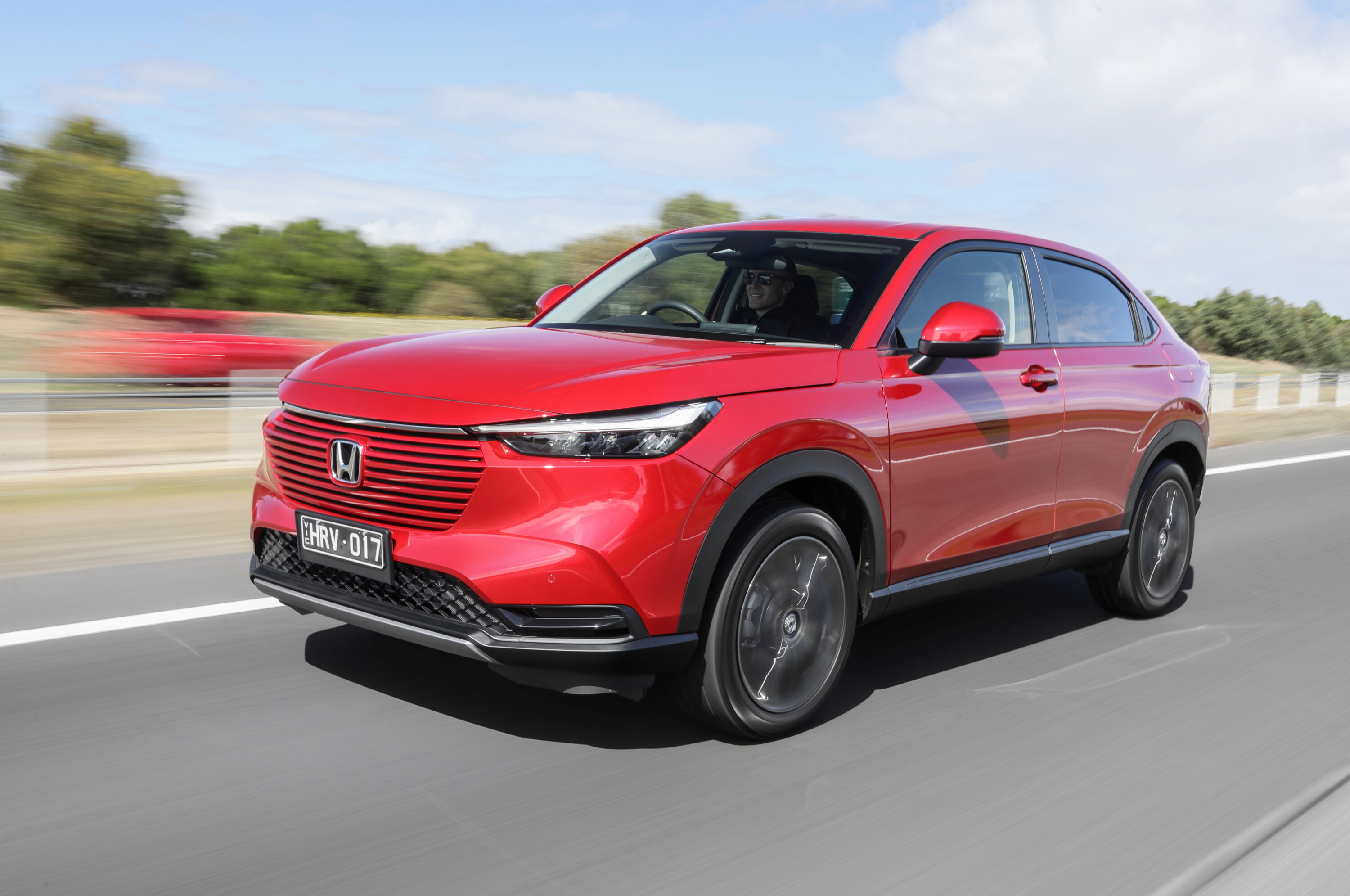 Reviews
Reviews2024 Honda Accord VTi-LX: Quick Review
Honda's tried and tested Accord is still kicking on, with plenty to offer families and couples alike
-
 News
News2025 New Car Calendar: All the new cars coming to Australia
Take a look at our list of what is expected to launch in Australia in 2025 – plus those we might not see locally just yet




